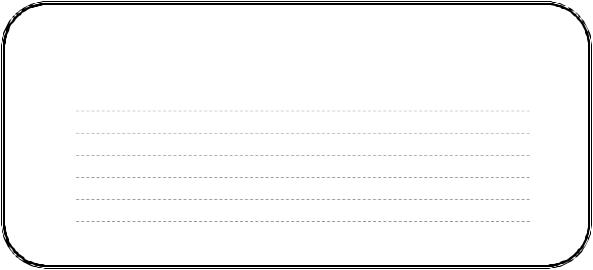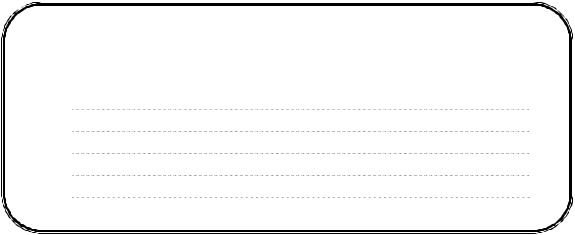
ENGLISH for Study and Work том 1
.pdfIndicative Reading
1.Баракова М.Я. Английский язык для горных инженеров. М.:Высшая школа, 1987. – 296 с.
2.Баракова М.Я., Шендерова Р.Л. Английский язык для горных инженеров. Пособие по обучению чтению. М.: Высшая школа, 1987.- 104 c.
3.Sweeney S. (2002) Communicating in Business. A short course for Business English Students. Cambridge: Cambridge University Press. - 155p.
4.‘Coaltrans’.
5.‘Engineering and Mining Journal’.
6.‘International Mining’.
7.‘Mining Magazine’.
8.‘World Mining Equipment’.
Useful Links:
1.Mining Magazine [online]. Available from: http://www.miningjournal.com/ mining_magazine/mining_mag_home.aspx - 38k
2.Engineering & Mining Journal [online]. Available from:
3.http:// www.e-mj.com
20019987
Module 4
Giving Presentations
2
Unit 1 Effective Presentation
Focus on
•reflecting on experience of making presentations
•understanding the importance of making presentations
•components of a good presentation
•key points of presentation preparation
•structure of an effective presentation
By the end of the unit you will be aware of:
•what makes a presentation effective
•the key elements of a presentation
•functions and functional exponents, phrases used while giving a presentation
•major elements of delivery
Lead-in
1. Pair-work. Read the following quotations. Do you agree with them? Why? Why not? Discuss with your partner.
‘Speech is the index of the mind’. |
(Seneca) |
|
|
|
|
|
|
|
‘Rhetoric is the art of ruling the minds’. |
(Plato) |
|
|
|
|
Brainstorming
2.Pair-work. Discuss the following questions with a partner:
•Do you have any experience in giving a speech in front of an audience? If so, what sort of speech was it?
•What was the situation?
•What was the purpose of your speech?
2023199

•What was your audience?
•Was your speech successful? Why? Why not?
3.Imagine that you are asked to give a speech. Think about the components of a good presentation. Fill in the worksheet below and discuss your notes with a partner.
WORKSHEET 4.1
Preparation |
• Objectives |
|
• |
|
• |
|
• |
|
• |
|
• |
Language |
• Vocabulary |
|
• |
|
• |
|
• |
|
• |
Delivery |
• Voice |
|
• |
|
• |
|
• |
|
• |
|
• |
203124
Reading and Taking notes
4. Read the tapescript of the first part of a presentation from Communication skills training course. Complete a presenter’s transparency (Fig. 4.1) with the key points.
Good morning everyone, and welcome to our seminar. This morning I'm going to give you guidelines for preparing and delivering talks and presentations. I've divided my presentation into three parts: first we'll deal with preparation, then we'll focus on language, and lastly we'll look at delivery. As you listen, you might like to take notes on key points. There'll be an opportunity to ask questions at the end of each section, but do interrupt me if there's anything you don't understand.
So, let's start with preparation. This stage is extremely important and there are six key areas you need to think about when preparing your presentation or talk. The first one is objectives. You need to think carefully about the aim of your talk, and what you want to achieve. Second, the audience. Think about who they are, and what they need to know. The third area is content. You need to be careful not to give your audience too much information. Concentrate on what they need to know, on what will interest them. The fourth area is organization. Your presentation needs to have a clear and logical organization so everyone can follow it without difficulty. We'll come back to this point later, when we look at language. The fifth area is visual information. Presenting information visually, for example on an overhead projector or a flipchart, adds interest to a presentation and makes it easier to follow, but it's important to make sure you don't give too much information at a time. The last key area is practice. When you've finished preparing your talk, practise giving it. This way you'll discover if there are any problems and be able to check the timing. It should also make you feel more confident. So, to summarize, at the preparation stage you need to think about six key areas: first objectives, second audience, third content, fourth organization, fifth visual information, and sixth practice.
204351

Fig. 4.1 A presenter’s transparency. Preparation
Giving talks and presentations:
Preparation
1 objectives
2
3
4
5
6
5. Read the tapescript of the second part of the presentation quickly, ignoring the gaps, to find out what signposting language is.
Right. Let's now turn our attention to the use of language, and in particular what we call 'signposting language'. It would be useful here if you look at the handout, 'Giving talks and presentations'. I won't go through each section, only draw your attention to some sections. If you look at the section 1) ……………, you'll see there are phrases for introducing your talk, for giving your audience an overview of what's to come. Further down, in section 2)..…………, there are phrases for introducing the different parts of your talk, and for moving from one part to the next. Later, in section 3) …….........., there are phrases for focusing the audience's attention on visual information. In section 4) ……………. you’ll find phrases for concluding your talk and in section 5) …..………… phrases for dealing with questions. You'll need to look at the handout more carefully later on, but I hope that gives you an idea of what I mean by 'signposting language' and the kind of phrases you need to use. Now, I think that's everything I want to say about language. Oh, there are just a couple of points... If you need to use technical words or jargon that the audience may not know, make sure you explain them clearly, and don't
205346
use long, complicated sentences, keep your sentences short and easy to follow. Simplify your vocabulary and sentence structure. Right. Are there any questions on what we've covered so far?
6. Read the text again carefully and complete gaps (1 – 5) with the names of the sections (A – J) from the handout the presenter refers to.
Giving talks and presentations
A Introducing the topic
This morning |
|
... ...I'm going to (talk about ) |
||||
Today |
|
I'd like to... |
(describe... |
) |
|
|
|
|
|
|
|
(explain ) |
|
The aim of my presentation this morning is to... |
|
|||||
I've divided my presentation into |
|
(three parts.) |
||||
|
||||||
My talk will be in |
|
|
|
|||
|
|
|
|
|
|
|
First, |
|
I'd like to |
|
|
|
|
|
(give you an overview of )... |
|||||
Second, |
|
I'll |
|
|
|
move on to |
|
|
|
|
|||
Then, |
|
|
|
|
focus on |
|
|
|
|
|
|
||
After that, |
|
we'll |
|
|
|
deal with... |
Finally, |
|
|
|
|
consider |
|
|
|
|
|
|
||
|
|
|
|
|
|
|
B Referring to questions
Feel free to interrupt me if there's anything you don't understand. If you don't mind, we'll leave questions till the end.
C Introducing each section
So, let's start with... (objectives...)
Now let's move on to... (the next part...)
Let's turn our attention to... (the question of...)
This leads me to... (my third point...)
Finally... (let's consider...)
2067543
D Summarizing a section
That completes my... (description of...)
So, to summarize... (There are five key points...)
EReferring backwards and forwards
I mentioned earlier... (the importance of...) I'll say more about this later.
We'll come back to this point later.
FChecking understanding
Is that clear?
Are there any questions?
G Referring to visual information
This |
transparency |
shows... |
|
diagram |
|||
|
|
||
|
|
|
|
If you look at this graph you can see... |
|
||
What is interesting in this slide is...
I'd like to draw your attention to... (this chart...)
H Referring to common knowledge
As you know...
As I'm sure you're aware...
I Concluding
That concludes my talk.
That brings me to the end of my presentation.
If you have any |
I'd be pleased |
to answer them. |
|
questions |
I'll do my best |
||
|
|||
|
|
|
Thank you for your attention.
2078654
J Dealing with questions
That's a good point.
I'm glad you asked that question.
Can I get back to you on that later? I'm afraid I don't have...
(the information at present).
I'm afraid I'm not the right person to answer that.
7. Read the tapescript of the last part of the presentation. Complete the presenter’s transparency with the key points.
Now we come to the last part, Delivery. You need to consider five key areas here. The first one is nerves. Most of us feel nervous when we speak in public, especially if we're speaking a foreign language. It can help if you breathe deeply. Breathing deeply calms you down and stops you speaking too quickly, which usually happens when you're nervous. The second area is voice. Obviously it's important to speak clearly and not too quickly, but it's also important to sound interesting. If your voice sounds monotonous your audience will fall asleep! Next, body language. Try to give the impression that you're relaxed and confident even if you're not, and try to avoid nervous gestures or movements. An important element of body language is eye contact, and keeping eye contact with the audience is important to keep them interested in what you're saying. For this reason you shouldn't read your talk or presentation. Instead, list key points on a flipchart or transparency, and refer to notes as well, if you need to. Stand rather than sit, but make sure you don't stand in front of visual information. And visual information is the fourth key area on our list. I mentioned earlier the importance of not presenting too much information at a time, and you saw in the handout phrases for focusing the audience's attention on what you want them to look at. Remember, too, to give them enough time to take in the information you're showing them. The fifth and final area is questions. The best policy is to answer questions in a
2089765

polite, diplomatic way. The phrases in the handout should give you some help here. So, to sum up, the five areas you need to think about when delivering your talk or presentation are nerves, voice, body language, visual aids, and questions. Well, this brings me to the end of my presentation. Thank you for your attention, and now if you have any questions I'll be happy to answer them. Yes, you have a question there...?*
_____________________________________________________________
*Adapted from Taylor, L. (1997) International Express Oxford: Oxford University Press, p. 127.
Fig. 4.2 A presenter’s transparency. Delivery
Giving talks and presentations:
Delivery
1 nerves
2
3
4
5
8. Return to the worksheet in 3. Compare your notes with the information from the tapescripts, make necessary changes, and add missing points.
Follow-up
9. A possible structure for a presentation given on the following page was proposed by Paul Emmerson. Use it as a planning checklist - you don't have to follow every step, but at least consider all the points.
The first letters make an acronym: Bomber B. Match the items in the presentation structure to their definitions. The first and the last have been done for you (Bang!-1, Bang!-7 ).
20910876
